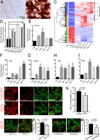Cardiac Fibroblasts Adopt Osteogenic Fates and Can Be Targeted to Attenuate Pathological Heart Calcification
- PMID: 27867037
- PMCID: PMC5291784
- DOI: 10.1016/j.stem.2016.10.005
Cardiac Fibroblasts Adopt Osteogenic Fates and Can Be Targeted to Attenuate Pathological Heart Calcification
Abstract
Mammalian tissues calcify with age and injury. Analogous to bone formation, osteogenic cells are thought to be recruited to the affected tissue and induce mineralization. In the heart, calcification of cardiac muscle leads to conduction system disturbances and is one of the most common pathologies underlying heart blocks. However the cell identity and mechanisms contributing to pathological heart muscle calcification remain unknown. Using lineage tracing, murine models of heart calcification and in vivo transplantation assays, we show that cardiac fibroblasts (CFs) adopt an osteoblast cell-like fate and contribute directly to heart muscle calcification. Small-molecule inhibition of ENPP1, an enzyme that is induced upon injury and regulates bone mineralization, significantly attenuated cardiac calcification. Inhibitors of bone mineralization completely prevented ectopic cardiac calcification and improved post injury heart function. Taken together, these findings highlight the plasticity of fibroblasts in contributing to ectopic calcification and identify pharmacological targets for therapeutic development.
Copyright © 2017 Elsevier Inc. All rights reserved.
Figures







Comment in
-
A Heart of Stone: Cardiac Fibroblasts Turn to Bone in Calcified Hearts.Cell Stem Cell. 2017 Feb 2;20(2):151-152. doi: 10.1016/j.stem.2017.01.003. Cell Stem Cell. 2017. PMID: 28157494
-
Role of "osteogenic" cardiac fibroblasts in pathological heart calcification.Stem Cell Investig. 2017 Apr 7;4:26. doi: 10.21037/sci.2017.03.05. eCollection 2017. Stem Cell Investig. 2017. PMID: 28447041 Free PMC article. No abstract available.
-
Finding the culprit: who is turning hearts to stone?Stem Cell Investig. 2017 Apr 21;4:33. doi: 10.21037/sci.2017.03.02. eCollection 2017. Stem Cell Investig. 2017. PMID: 28529948 Free PMC article. No abstract available.
References
-
- Abdallah BM, Ditzel N, Kassem M. Assessment of bone formation capacity using in vivo transplantation assays: procedure and tissue analysis. Methods Mol Biol. 2008;455:89–100. - PubMed
-
- Chen C, Uludag H, Wang Z, Jiang H. Noggin suppression decreases BMP-2-induced osteogenesis of human bone marrow-derived mesenchymal stem cells in vitro. J Cell Biochem. 2012;113:3672–3680. - PubMed
Publication types
MeSH terms
Substances
Grants and funding
LinkOut - more resources
Full Text Sources
Other Literature Sources
Medical
Molecular Biology Databases
Miscellaneous

